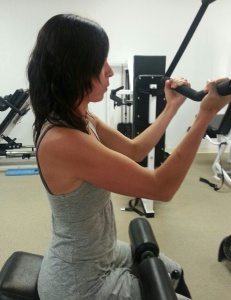Knowledge is Power
What is High Intensity – Low Momentum exercise?
 A lot has been written about it, but to get the best understanding of it, watch this video to give you a better idea. The method is based on the SuperSlow® protocol, popularized by Ken Hutchins, and focuses on slow movement and high weights, while giving muscles proper rest between workouts.
A lot has been written about it, but to get the best understanding of it, watch this video to give you a better idea. The method is based on the SuperSlow® protocol, popularized by Ken Hutchins, and focuses on slow movement and high weights, while giving muscles proper rest between workouts.
How does it work?
As you might expect, you use your strength against weight resistance set to your ability level. However, each press, or rep, is completed as a full cycle (out and in, or up and down, etc.) very slowly, about 16 to 20 seconds per rep, taking the same amount of time in each direction. That is, slow “out” and then slow “in”, so your muscles cannot rest and delay fatigue. The weight resistance is set to the top of your ability, to ensure that your muscles reach true fatigue between 90 and 120 seconds. The fatigue in your muscles triggers your body to grow more muscle tissue between workouts, which leads to greater strength.
What is muscle fatigue?
The muscle can no longer move to complete the positive movement, but is able to try to move the weight for an additional 10 seconds. Muscle fatigue happens when the muscle can no longer move to complete the cycle but is able to try to move the weight for an additional 10 seconds. Muscle fatigue is the key to muscle growth, so the sooner it happens, the more efficiently your body will create more muscle and become stronger.
Is this cardio?
It is! During our workout, the working muscles place a significant demand on the heart to supply them with oxygen and nutrients and to remove metabolic wastes. By limiting any rest between each exercise, an elevated heart rate is maintained for the duration of the workout, providing better cardiovascular conditioning than aerobics, more safely and efficiently.
How do we start?
We schedule a private, complimentary appointment for 60 minutes to discuss your goals, conditions, and health background, and try a workout together on our equipment. We may start you with just a few machines at a lower weight level, to get you familiar with the form and function, and build from there in the next session or two. By the third session, you’ll perform the full workout regimen, tailored to your body.
Why strength training?
Strength training is the most effective way to build strength. As your body ages from 20 to 50, you will lose an average of 15 POUNDS of muscle mass, and replace it with 30 POUNDS of fat, just due to changes in your metabolism. Strength training can promote a healthy metabolism, improve your stamina and energy, strengthen your bones, reduce your risk of injuries— the list of benefits keeps going. In short, a strong body lives a comfortable life.
Do women really need strength training?
YES, possibly more than men do, as we age. Unlike men, women’s bodies do not become excessively muscular as their strength increases— our hormones simply prevent bulky muscles. Strength training can stave off the effects of osteoporosis, heart disease, and injuries related to bones and joints. Every woman can benefit from strength training!
What major areas of my health will strength training enhance?
Strength training is more than just muscle growth!
- Strength
- HDL Cholesterol
- Bone density
- Vascular Efficiency
- Joint stability and protect
- Stamina
- Blood glucose levels
- Mobility
